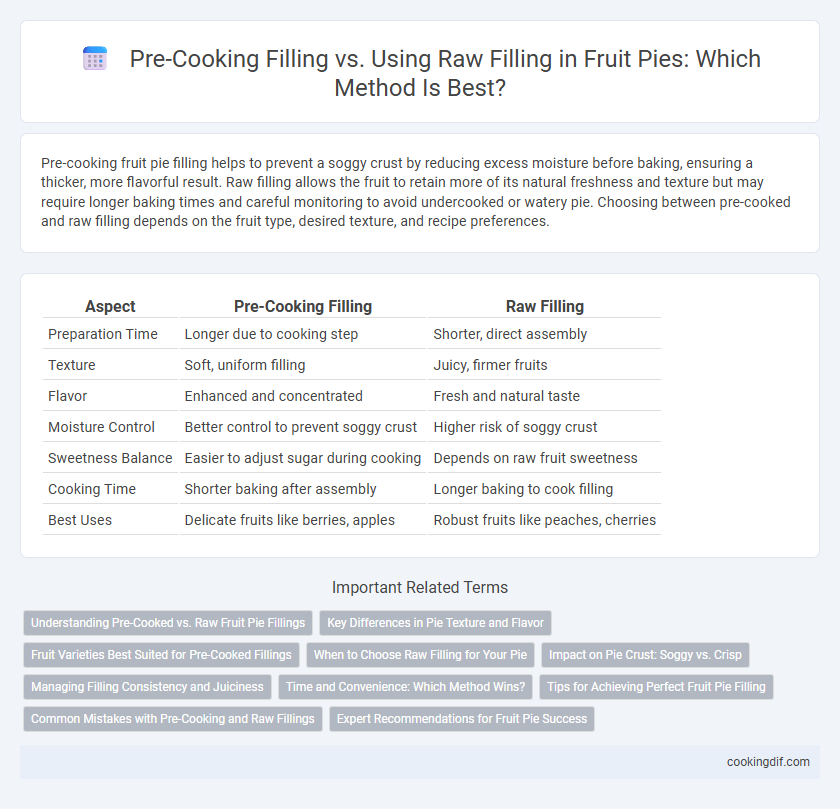Pre-cooking fruit pie filling helps to prevent a soggy crust by reducing excess moisture before baking, ensuring a thicker, more flavorful result. Raw filling allows the fruit to retain more of its natural freshness and texture but may require longer baking times and careful monitoring to avoid undercooked or watery pie. Choosing between pre-cooked and raw filling depends on the fruit type, desired texture, and recipe preferences.
Table of Comparison
| Aspect | Pre-Cooking Filling | Raw Filling |
|---|---|---|
| Preparation Time | Longer due to cooking step | Shorter, direct assembly |
| Texture | Soft, uniform filling | Juicy, firmer fruits |
| Flavor | Enhanced and concentrated | Fresh and natural taste |
| Moisture Control | Better control to prevent soggy crust | Higher risk of soggy crust |
| Sweetness Balance | Easier to adjust sugar during cooking | Depends on raw fruit sweetness |
| Cooking Time | Shorter baking after assembly | Longer baking to cook filling |
| Best Uses | Delicate fruits like berries, apples | Robust fruits like peaches, cherries |
Understanding Pre-Cooked vs. Raw Fruit Pie Fillings
Pre-cooking fruit pie fillings concentrates flavors and reduces excess liquid, resulting in a firmer and less soggy crust. Raw fillings release juices during baking, creating a more traditional, juicy texture but may require a thickener to prevent a runny pie. Choosing between pre-cooked and raw fillings depends on desired texture, flavor intensity, and baking time considerations for optimal fruit pie results.
Key Differences in Pie Texture and Flavor
Pre-cooking fruit pie fillings softens the fruit and thickens the filling, resulting in a smoother texture and more concentrated flavor. Using raw filling allows juices to release naturally during baking, creating a juicier filling with fresher fruit taste but sometimes soggy crust. The choice affects bake time and final pie consistency, with pre-cooked fillings offering more control over texture and raw fillings preserving fruit's natural brightness.
Fruit Varieties Best Suited for Pre-Cooked Fillings
Fruit varieties best suited for pre-cooked pie fillings include apples, pears, and peaches, as their firm texture holds well through the cooking process. Berries such as blueberries and raspberries also benefit from pre-cooking to reduce excess moisture and enhance flavor concentration. Using firm-fleshed fruits in pre-cooked fillings ensures a balanced texture and prevents soggy crusts in fruit pies.
When to Choose Raw Filling for Your Pie
Choosing raw filling for your fruit pie is ideal when using fruits with high water content like berries or peaches, as it preserves their natural texture and flavor. Raw filling allows the juices to thicken during baking, preventing soggy crusts and creating a balanced consistency. This method is preferred for delicate fruits that soften quickly and release sufficient liquid when heated.
Impact on Pie Crust: Soggy vs. Crisp
Pre-cooking fruit pie fillings reduces excess moisture, preventing a soggy crust by allowing better control over thickening and evaporation. Raw fillings release juices during baking, increasing the risk of a wet, mushy bottom crust that compromises flakiness and texture. Using pre-cooked fillings improves crust crispness and structural integrity, enhancing the overall pie quality.
Managing Filling Consistency and Juiciness
Pre-cooking fruit pie filling helps control excess moisture by thickening juices and breaking down fruit, resulting in a consistent texture that prevents soggy crusts. Raw filling retains more natural juiciness and flavor but requires careful balancing of thickeners like cornstarch or flour to absorb liquid during baking. Managing filling consistency ensures optimal pie structure and prevents watery or overly dry outcomes, crucial for fruit varieties with high water content such as berries and apples.
Time and Convenience: Which Method Wins?
Pre-cooking fruit pie fillings significantly reduces baking time by softening the fruit and concentrating flavors before assembling the pie, streamlining the process for quicker oven use. Raw filling requires longer baking to achieve the desired texture, which can extend overall preparation and cooking time. Choosing pre-cooked filling enhances convenience, making it the preferred method for efficient pie-making without sacrificing taste.
Tips for Achieving Perfect Fruit Pie Filling
Precooking fruit pie filling helps control moisture content and prevents soggy crusts by reducing excess liquid while intensifying the natural fruit flavors. Using raw fruit filling requires careful selection of fruits with low water content and incorporating thickening agents like cornstarch or tapioca to absorb juices during baking. Balancing sugar and acidity enhances the taste, and allowing the filling to cool before assembling ensures even cooking and optimal texture in the finished pie.
Common Mistakes with Pre-Cooking and Raw Fillings
Using pre-cooked fillings in fruit pies often leads to overcooked or mushy textures because the fruit releases excess moisture during the baking process. Raw fillings risk undercooking the fruit or producing a soggy crust due to insufficient thickening and moisture management. A common mistake is neglecting to adjust sugar, thickening agents, and baking time based on whether the filling is pre-cooked or raw, which significantly impacts pie consistency and flavor.
Expert Recommendations for Fruit Pie Success
Experts recommend pre-cooking fruit pie filling to prevent soggy crusts and ensure even flavor distribution, especially with high-moisture fruits like berries and stone fruits. Raw fillings may release excess liquid during baking, resulting in a watery consistency and undercooked crust areas. Pre-cooking allows precise control over sugar, thickener ratios, and spice blending, enhancing the overall texture and taste of fruit pies.
Pre-cooking filling vs raw filling for fruit pies Infographic

 cookingdif.com
cookingdif.com